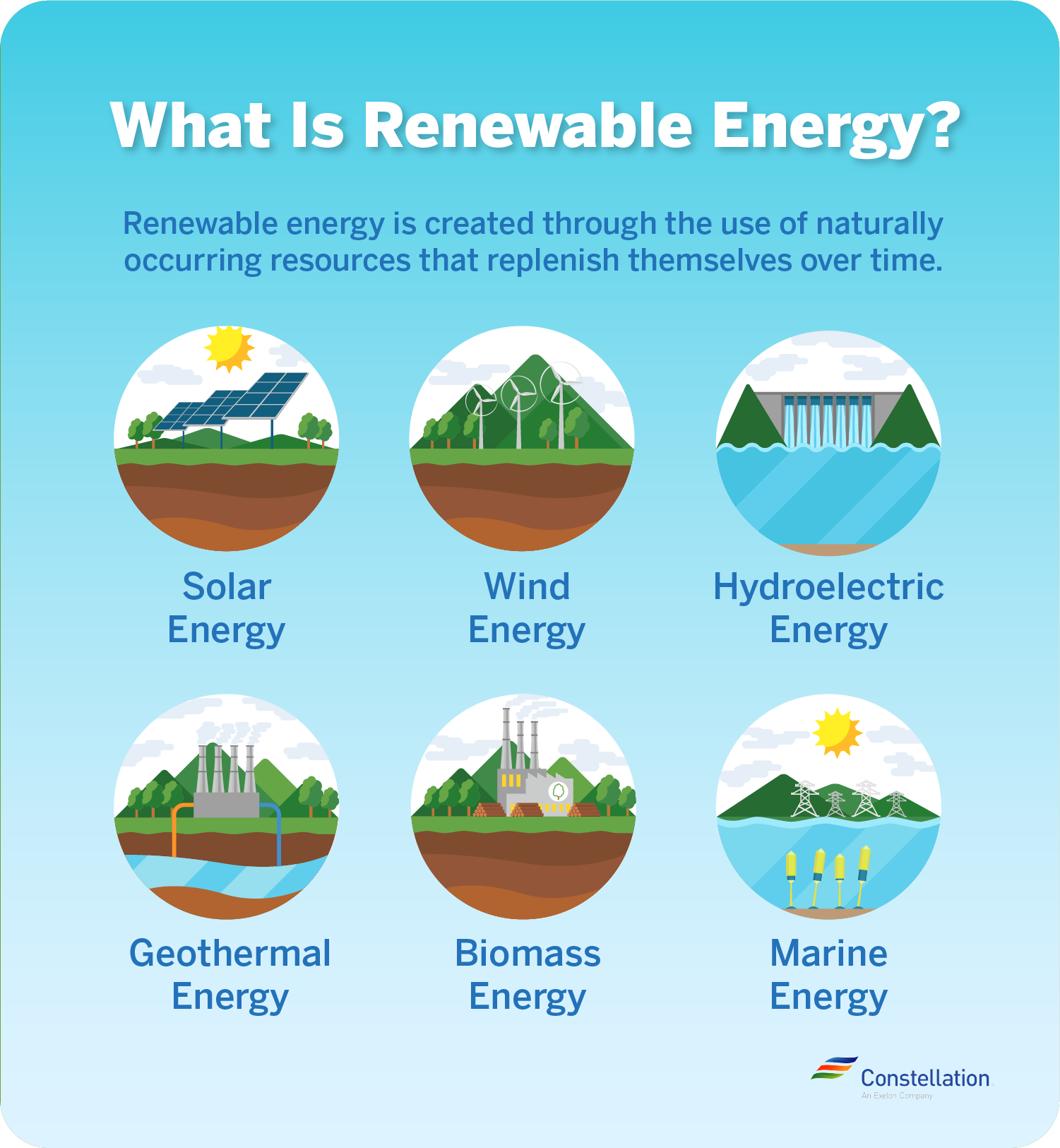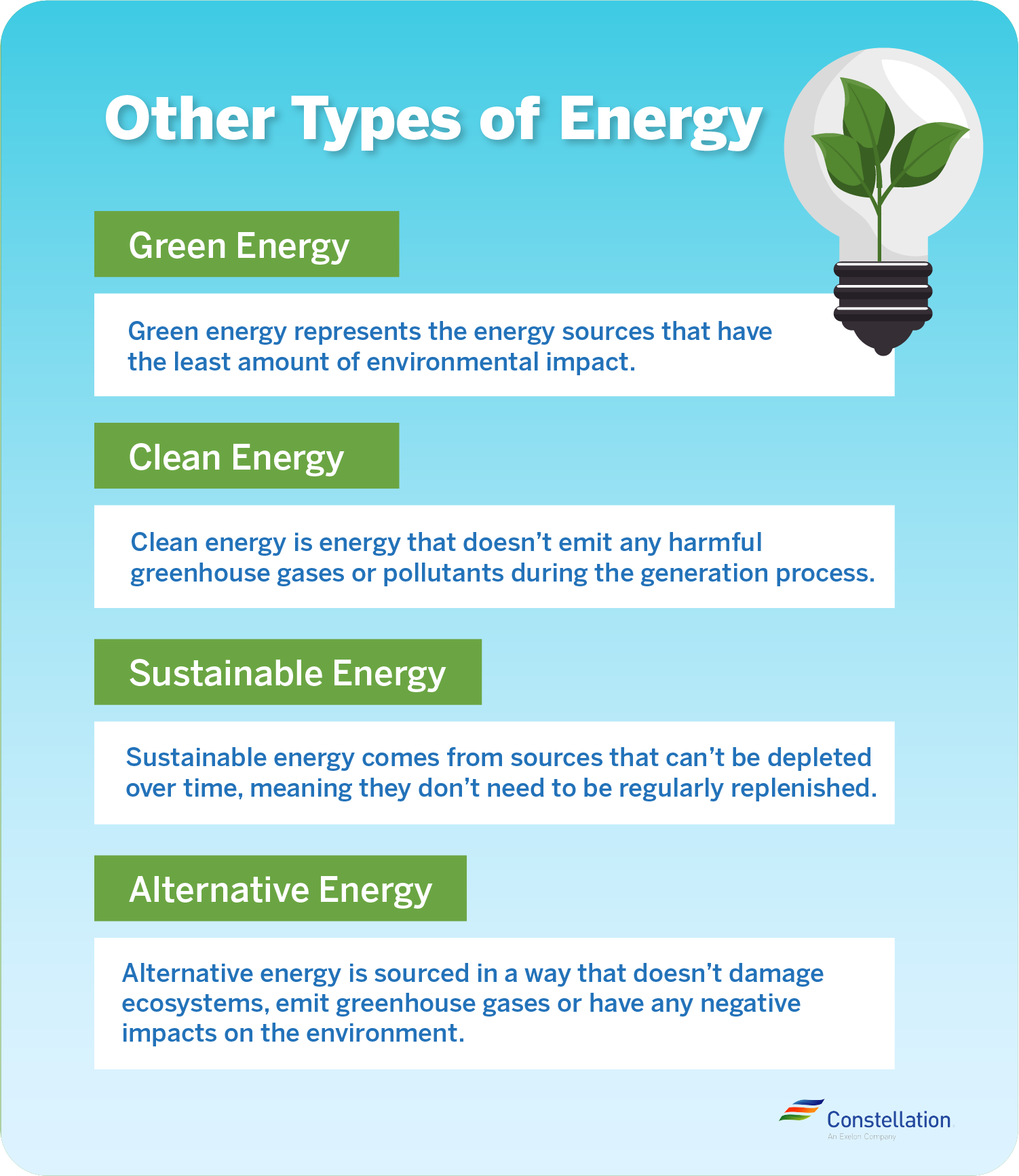
- Category:
Green Energy -
Last updated:
January 19, 2022
The Differences Between Green Energy, Renewable Energy and More
Fossil fuels, such as coal and natural gas, have been our country’s primary source of power for decades. However, the process of getting fossil fuels out of the ground and into your home creates pollution and damages ecosystems. That’s why more and more people have been pushing for cleaner, renewable energy solutions. These include green energy, clean energy, sustainable energy and more.
Although terms like renewable energy, green energy and clean energy are often used interchangeably, there are actually some key differences that set them apart. Here, we’ll take a look at various types of renewable energy solutions, what makes them different from one another and how they’re helping us move toward a future that isn’t dependent on fossil fuels.
What is renewable energy?
Renewable energy is created through the use of naturally occurring resources that replenish themselves over time. So, although there’s not an unlimited amount of these resources available at any one moment, you’ll almost never have to worry about a renewable resource running out entirely. And since renewable energy produces fewer greenhouse gases and pollutants than traditional fossil fuels, they can help to make your home more sustainable.
In 2019, the amount of energy provided by renewable sources equaled 11.4% of total U.S. energy consumption. However, the U.S. Energy Information Administration anticipates that renewable energy consumption in the United States will continue to increase through 2050.

Types of renewable energy sources
To better understand what renewable energy is and how it works, it helps to take a look at some examples of renewable energy sources and the technologies that power them. Among the most common of these sources are:
- Solar energy. To create solar energy, photovoltaic cells on solar panels trap sunlight. Then, an inverter converts the sunlight into electricity that can be used in your home.
- Wind energy. Wind energy works by harnessing air movement to rotate the blades on large wind turbines. The turbines then convert the kinetic energy of the rotation to mechanical power and, eventually, electricity.
- Hydroelectric energy, or hydropower. One of the first energy sources used to generate electricity was hydropower. In this process, the force of running water turns the blades in a turbine, which then spins the generator that produces electricity.
- Geothermal energy. Geothermal energy comes from heat located deep within the earth’s interior. It works by drilling wells into the ground, which then allows steam or water to reach the surface and power the turbines that create electricity.
- Biomass energy. Biomass is a renewable material that comes from plants and animals. Some common biomass sources include wood, agricultural crops and municipal solid waste. Biomass can be converted into energy using several different methods, but the most popular approach is burning the biomass to heat buildings or power steam turbines that make electricity.
- Marine energy. Although it’s still an emerging technology, marine energy leverages the ocean’s natural movements to produce energy. There are a few different types of marine energy sources being developed, such as wave energy, tidal energy, and energy from ocean currents.
Other types of energy, explained
The United States has access to a variety of energy resources, from fossil fuels to renewables. However, not all types of energy in the United States fit neatly into one of these two categories. For example, energy can also be classified as green, clean, sustainable, or alternative. Below, we’ll define these types of energy and explain what differentiates them from renewable energy.

What is green energy?
Green energy, or green power, represents the energy sources that have the least amount of environmental impact. These types of energy sources don’t release harmful carbon emissions, meaning they’re effective at helping you reduce your carbon footprint. Some examples of green energy include electricity produced from solar, wind, geothermal and other low-impact sources.
Green energy vs. renewable energy
Green energy is actually a subset of renewable energy and includes those renewable energy resources that offer the greatest environmental benefit. So, although all green energy resources are renewable, not all renewable resources are considered green. For example, wind power is green and renewable; burning wood is renewable (because you can grow more trees) but not green (because it releases pollution into the atmosphere).
What is clean energy?
Clean energy is energy that doesn’t emit any harmful greenhouse gases or pollutants during the generation process. This means that all green and renewable energy sources are also clean by definition. That said, an energy source doesn’t have to be renewable to be considered clean. For example, nuclear power is a clean energy source despite the fact that it doesn’t naturally replenish over time.
What is sustainable energy?
Sustainable energy comes from sources that can’t be depleted over time, meaning they don’t need to be regularly replenished. Some examples of sustainable energy sources include both solar and wind energy. Compare these sources to wood, crops and other biomass materials that are capable of being depleted and require time — as well as possible human intervention — to replenish.
What is alternative energy?
Alternative energy is sourced in a way that doesn’t damage ecosystems, emit greenhouse gases or have any negative impacts on the environment. So, while energy sources like biomass and hydropower are renewable, they affect the environment too much to be considered alternative. For example, sourcing biomass materials can lead to deforestation, and hydropower systems can negatively influence the habitats and feeding cycles of both water and land animals.
Making the switch to renewable energy sources
Have you ever wondered how you can help shrink your carbon footprint? It’s easier than you think. For example, you can get started with renewable energy certificates (RECs) and carbon offsets. Or you may decide to take a bigger leap and find a solar provider for your home. Ultimately, anything you can do to begin shifting away from fossil fuels will help ensure that our environment thrives well into the future.
Constellation currently offers customers in 11 states renewable home energy solutions that include plans sourced by 100% wind power. Find out how a fixed-rate renewable energy plan can help you achieve price certainty and predictability through your entire contract period while also helping to support the environment.




